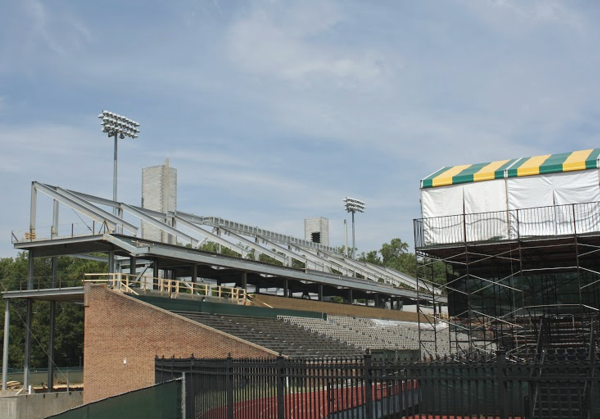If you’re a student who thought the College of William and Mary was on your side, you’re sadly mistaken. Our administration says it’s focused on our needs, but recent events suggest another motive: Money.
I’m talking about the most recent — unadvertised — tuition increase. Zable Stadium has undergone renovations over the past year and a half, costing an estimated $27 million. The College’s website, public officials, and a private audit have all claimed that the entire cost was paid for with private donations. In fact, only $24.5 million was provided in private funds. If you look closely at your 2016-2017 semesterly tuition and fees, you’ll see a new category added: Zable Stadium, totaling $18 per semester.
Of course, this is a small and seemingly trivial amount unworthy of your outrage. But the College has quietly and carefully slipped it in, with no public student input, and it’s one decision in a line of many that should lead us to question the College’s priorities.
It’s not the only mounting cost.
This semester you will be putting $60 towards building the new Integrative Wellness Center and $119 towards ISC renovations, in addition to your Zable-specific fees. That’s $394 in new construction per year (not including other renovation plans that have not started yet), or $1,576 over four years.
There are plenty of other costs: $151 towards the Business School, $15 towards the School of Education, and $916.50 towards intercollegiate athletics. That adds up to $2,165 per year, or $8,660 over four years. Many of these programs may have nothing to do with you, and could just as easily be paid for exclusively by those who use them.
Business, education and athletics are important, but for many of us, these expenses make it hard to pay for college. Many students will not see any benefits, though they will still be required to pay.
In other words, you’re paying $1,576 for fancy renovations (at the very least) and $8,660 for programs that many of us will not use. That adds up to $10,464 that could be reduced, given student input, or used more efficiently based off a clearer evaluation of student priorities. Per year, that’s $2,616. Of course, integrating student input would be difficult. The Board of Visitors currently allows public access for parts of their meetings, but no public comment. If students were allowed a say, I suspect many would propose spending less money on amping up our football stadium (considering so few people are drawn to William and Mary because of our football program), advocate for more substantive changes within mental health counseling and student services, and value the school spending money on attracting the best professors, instead.
Part of the challenge with the Zable renovations is that a donor earmarked funds to be used toward the stadium. But it’s the school’s responsibility to ensure their budget doesn’t bleed over into student tuition and fees, especially when it’s unlikely these renovations will be profitable — our football team will not suddenly yield us hundreds of new applicants over the next few years, and athletics have never been considered our competitive advantage, given our size and reputation for academics. In short, it’s not a good investment, which was fine when only donor funds were being used. Now, students’ finances are being affected.
The easiest rebuttal would be that one should not go to William and Mary if they do not want to pay the cost. The issue is deeper than that: It’s a matter of lack of student input, intentional opaqueness, and a cost of attendance that’s rising far faster than that of our peers. This academic year saw a 12 percent tuition hike for the incoming freshmen, compared to U. Va’s 1.4 percent and Virginia Tech’s 2.9 percent.
The concept behind public universities is that they provide accessible education to all in-state students, financed partially by the state in order to ensure minimal cost. The College is not affordable for many, particularly with the new COLL requirements, which make it far harder to graduate early than under the GER system. These barriers to attendance will only worsen.
None of this should be interpreted as a battle cry against student athletes or our athletics programs. Student athletes demonstrate next-level work ethic and badassery, and we would probably benefit from having more social integration of athletes and non-athletes. The issue here is that the cost of attendance is rising to an unreasonable degree that will cut off access to low-income students, forcing our school to become an echo chamber of students from one type of socio-economic background. And the worst part? Our administration didn’t even mention this to us, choosing instead to cunningly slip it into our tuition and fees without a word.
Email Liz Wolfe at elwolfe01
College spokesperson Brian Whitson issued the following statement Sept. 11:
“There is missing context here. The 12 percent increase is only for entering students at W&M and the rate is guaranteed not to increase. For continuing in-state students at W&M, the tuition increase was zero. In addition, I’m pretty sure the 1.4 percent increase at UVA is just for continuing students and I read coverage that the entering class in Charlottesville received an increase of 9.5 percent, which was not guaranteed. So not apples to apples with any rate that is not guaranteed. Here is the report (see page 5) in the senate finance committee:http://sfc.virginia.gov/pdf/committee_meeting_presentations/2016%20Interim/051816_No2_Preliminary%20Tuition%20and%20Fee%20Report.pdf
If you cite 1.4 percent increase at UVA, the comparative number at W&M is zero.“

